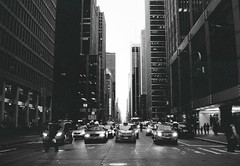 Differences between mother and daughter, or or which is the same: » The generational gap» are, as José Joaquín Brunner explaines in his article «Brecha generacional»: «Throughout history, a major source of cultural change have been young people, whose collective rebellion usually manifests a profound mismatch with authority structures and practices of adult values and social transmission. Hence also the nature of generational conflict that usually accompanies the youth movements, barely hidden behind reasons of participatory or democratization.»
Differences between mother and daughter, or or which is the same: » The generational gap» are, as José Joaquín Brunner explaines in his article «Brecha generacional»: «Throughout history, a major source of cultural change have been young people, whose collective rebellion usually manifests a profound mismatch with authority structures and practices of adult values and social transmission. Hence also the nature of generational conflict that usually accompanies the youth movements, barely hidden behind reasons of participatory or democratization.»
To begin with, we must understand why do this generation gaps occur. At some time in our lives, we have all felt that our parents do not understand us, that they were from another world. This is mainly caused by several factors such as a change in the political or social situation of a country, the different points of view of the same world that both parts have…
In some cases such as Kingston’s, this gap becomes even bigger because her parents were born and raised in China (acquiring its traditions and values), while, Kingston, was born and raised the US. In other words, they moved from a communist and strict country to a totally capitalist and liberal one. This might also cause a fracture of identity and of belonging to the new generations. Obviously it was much harder for the progenitors to get used to this new and, somehow extrange situation than for their children. Maxime learnt, among other things, that women do not have to get married to feel fulfilled with themselves, that there was a world out of her parent’s silence, a world full of opportunities to women.
As we have seen in the book, Brave Orchid (Maxim’s mother) even been an opend minded woman, do not accept or understand some of her daughter’s worries and fears. She is still very linked to China (Maxime’s family sent them money because they were pursued by the communist government) and tries her children to be linked in same way (we are told several stories and myths such as Fa Mulan’s during the book). Besides, Maxime and her sister have to go to the chinese school after the american one.
During the book, it is evident for the reader this lack of cummunication and of understanding between mother and daughter, which on the other hand, is totally understandable and normal. Even though, and in contrast with what we have said before, there is also a clear feeling of admiration towards her mother’s strengh, as we can see in the third part of the book: Shaman. In which Brave Orchid has to fight several «ghosts» (from Aitor Ibarrola’s point of view this ghosts might be Brave Orchids fears or nightmares).
To sum up, we can say (according to the book and to Aitor Ibarrola’s lectures) that even if the generational and cultural gap is still evident, Maxime finds a voice to claim who she is and where she belongs to by respecting her parent’s cultural procedence, and absorving her new culture as if she were a sponge.
References:
- The Woman Warrior. (2011, September 11). In Wikipedia, The Free Encyclopedia. Retrieved 12:31, November 27, 2011, from http://en.wikipedia.org/w/index.php?title=The_Woman_Warrior&oldid=449766324
- Maxine Hong Kingston. (2011, October 11). In Wikipedia, The Free Encyclopedia. Retrieved 12:33, November 27, 2011, from http://en.wikipedia.org/w/index.php?title=Maxine_Hong_Kingston&oldid=455036704
- Patricia O’Connell (August 14, 2008). In Bloomberg Businessweek. Retrieved November 27, 2011 from http://www.businessweek.com/magazine/content/08_34/b4097060796052.htm
- Maxine Hong Kingston. (2011, October 11). In Wikipedia, The Free Encyclopedia. Retrieved 16:33, November 27, 2011, from http://en.wikipedia.org/w/index.php?title=Maxine_Hong_Kingston&oldid=455036704
- Aitor Ibarrola’s lectures.














